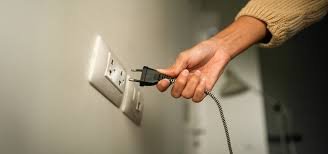The Hidden Cost of Vampire Power: What’s Draining Your Electricity While You Sleep
Most of us expect our homes to be still and quiet when we’re asleep or away. Lights are off, doors are locked, and we assume everything is at rest. But what if your house isn’t really “asleep”? No, this isn’t a story about ghosts—or your teenager sneaking snacks at midnight. This is about something much more subtle and far more common: vampire power.
Also known as standby power, vampire power is the steady trickle of electricity that appliances and electronics continue to draw even when they appear to be turned off. It earns its spooky nickname by “silently sucking” energy from your outlets—often without your knowledge.
Take a look around your home. Is your TV off? It’s probably still using power in standby mode. That glowing clock on your coffee maker? It’s quietly using energy too. Even your phone charger, when plugged in without a phone attached, continues to draw power. All of these little energy leaks add up—and you’re paying for every single one.
💡 What Is Vampire Power, and Why Should You Care?
Vampire power—sometimes called phantom load, leaking electricity, or simply standby energy—refers to the energy consumed by devices when they are plugged in but not actively in use.
Here’s why it happens:
- The device is technically “off” but still plugged into the wall.
- It’s on standby, waiting for a remote signal (like your TV).
- It has features that need constant power, such as clocks, indicator lights, or fast-start options.
- Chargers that remain plugged in even when they’re not charging anything.
Common culprits include:
- Phone and laptop chargers (even when not connected to a device)
- Smart TVs and sound systems
- Game consoles
- Coffee makers with digital displays
- Microwaves, printers, desktop computers
- Electric toothbrush and vacuum chargers
While each device may only draw a small amount, combined, they can account for 5–10% of your home’s electricity use. That’s like leaving a small appliance running around the clock—and paying for it year after year.
💸 What Vampire Power Costs You
Let’s be clear—you won’t retire early just by unplugging a few gadgets. But the savings are real and can add up. Depending on how many devices you have, cutting down on standby power could save you between $100 and $200 per year.
Here’s a breakdown of what some devices might be costing you annually—even while “off”:
| Device | Estimated Yearly Cost |
|---|---|
| Gaming Console (PS5, Xbox, etc.) | $30 – $60 |
| Cable Box or Satellite Receiver | $40 – $80 |
| Coffee Maker with Clock | $10 – $15 |
| Laptop Charger (always plugged in) | $5 – $10 |
| TV and Soundbar | $25 – $50 |
Now imagine this multiplied across dozens of items in your home. That’s real money trickling out of your budget for nothing.
⚠️ What NOT to Unplug
Before you rush to yank cords from every outlet in sight, remember: not everything should be unplugged.
Keep these devices plugged in for safety and practicality:
-
- Refrigerator & Freezer: Unplug only if you’re going away for a long time. Otherwise, you risk spoiled food and bad smells.
- Medical Equipment: Devices like CPAP machines or oxygen concentrators should always remain connected.
- Wi-Fi Routers: These can be shut off on a schedule, but if you rely on them for work or smart home devices, it’s safer to leave them on.
- Security Systems and Baby Monitors: Always keep these operational. Your peace of mind and safety depend on them.
- Modems or Routers (with smart devices): Many smart home systems go offline without a constant internet connection.
Some electronics—like cable boxes—also take forever to reboot, so weigh convenience vs. savings before unplugging.
✅ Smart Ways to Stop the Drain Without the Hassle
You don’t need to become a power-usage expert or develop a new unplugging routine. A few clever habits and tools can drastically cut your standby power use with little effort.
- Use Smart Power Strips: These strips can automatically cut off power to “secondary” devices when the main one is turned off. Example: When you shut off the TV, the strip will also shut off your soundbar and game console.
- Group Devices with Standard Power Strips: Plug several kitchen appliances (coffee maker, toaster, blender) into one strip. Flip it off at night. Do the same for home office or entertainment setups.
- Unplug Chargers When Not in Use: It takes seconds and becomes a habit with practice—just like turning off lights when leaving a room.
- Buy Energy-Efficient Devices: Look for the ENERGY STAR® label when shopping for electronics. These products use less standby power and save more long-term.
- Follow the “Last One Out” Rule: Before heading to bed or leaving home, do a quick sweep—turn off or unplug non-essential devices. It’s a small habit that can lead to big savings.
🌍 Final Thoughts
Vampire power may seem like a small issue, but over time, it’s draining energy, money, and resources unnecessarily. With a few small changes, you can reduce your electricity use, lower your utility bills, and make your home more efficient—without sacrificing comfort or convenience.
So the next time you see that little glowing light on a “turned-off” device, remember: it’s not off—it’s just quietly costing you.
